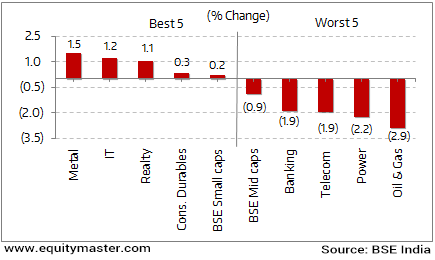Global markets ended on a mixed note in the week gone by. While markets in the developed economies ended in green, the indices in emerging economies fell.
The US stock markets closed out their sixth straight week of gains. However, markets witnessed some correction on the last trading day of the week, after US Fed Chairperson Janet Yellen’s comments. Yellen signaled the Federal Reserve will increase interest rates this month if employment and other economic data hold up. The Fed meet is scheduled on March 14-15.
Major European stocks closed the week on a firm note. The UK indices witnessed volatility during week gone, though index closed up 1.8% marking its best weekly gain in the last 3 months. British services sector data was released during the week. The reported growth in the services sector was below expectations, pointing slowing British economic growth.
Back home, Indian indices closed the week on a flattish note down (0.2%). The GDP data released during the week, surprised experts and market participants. The markets neared the two year high levels during the week gone by. However, the benchmark indices snapped five-week long gaining spree and closed in red. The investors preferred to book profits ahead of the US Federal Reserve’s policy meet.
Key World Markets During the Week

On the sectoral indices front, metal and IT stocks led the gainers this week. On the other hand, stocks from oil and gasand power sector witnessed selling pressure.
BSE Indices During the Week

Now let us discuss some key economic and industry developments during the week gone by
The Central Statistical Office (CSO) surprised the nation when it released advanced estimates of Gross Domestic Product (GDP) growth for the October-December quarter. India’s economic growth of 7% has sparked a debate on how output grew so fast at a time when the country was facing it’s biggest-ever cash crunch, after demonetisation weeded out 86% of the currency notes in circulation.
Vivek Kaul, has been extremely vocal about it. The currency in circulation had crashed during demonetisation. Given the bulk of transactions in India being carried in cash, he is extremely skeptical of the high private consumption levels during the December quarter.
Here’s Vivek.
In this environment, how did private consumption expenditure grow by 10.1 per cent, the second fastest since June 2011, is a question worth asking?
You can read the complete article in his diary here.
In news from India’s manufacturing sector. The manufacturing sector continued its rebound from the notebandi induced downturn. The sector expanded marginally in February as a rebound in export demand contributed to a stronger expansion of total new orders, according to the Nikkei Purchasing Managers’ Index (PMI) survey by Markit. Having deteriorated in December for the first time in one year, the health of India’s manufacturing economy showed signs of improvement in January 2017.
The manufacturing PMI recovered from 49.6 in December 2016, to 50.4 in January 2017 and continued moving upwards marginally to 50.7 in February. The Manufacturing PMI is an indicator of manufacturing activity. A reading above 50 indicates expansion, while any score below the mark denotes contraction. The indicator suggests an upturn in the manufacturing activity in February, charting a steady rise since January.
Manufacturing activity in December was hit due to notebandi induced liquidity crunch, lower orders and muted outputs. February is the second straight month in which the manufacturing sector improved after the notebandi move.
The main factors contributing to the marginal PMI increase in February were a strong export demand and a rise in output and orderbook. However, the latest reading was much weaker than the long-run series average of 54.2, largely reflecting sub-par growth for output and new business. Confidence among Indian manufacturers was relatively subdued in February.
Higher commodity prices resulted in increased cost burden facing manufacturers. The sharp rate of inflation seen in February was the most pronounced in two-and-a-half years and led factory charges to be raised at the quickest pace in 40 months. A surge in inflation is likely to cause demand from price-sensitive consumers to fall and potentially jeopardise the economic recovery.













Leave A Comment